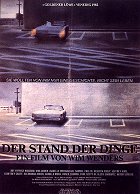Rendező:
Wim WendersForgatókönyvíró:
Wim WendersSzereplők:
Isabelle Weingarten, Camilla More, Patrick Bauchau, Samuel Fuller, Allen Garfield, Roger Corman, Robert Kramer, Geoffrey Carey, Viva, Rebecca Pauly (több)Tartalmak(1)
A német független filmes amerikai megrendelésre készíti a Túlélők című filmet Portugáliában. A forgatás azonban pénz- és nyersanyaghiány miatt leáll. A színészek tetszhalálba merevednek a dologtalan időszakra, mindenki más elfoglaltság után néz. A producer megszökik, a rendező utána indul, és Los Angelesben találja meg őt, ahová hitelezői elől menekült. Beszélgetéseikből a rendező számára is világossá válik – az európai és az amerikai filmgyártás éles ellentéteként -, hogy a világ filmes moguljainak akció, emberfeletti hős és színes látvány kell, nem fekete-fehér valóság. Amikor a megbízók megtalálják őket, a rendező nem tud mást tenni, mint – fegyverként maga elé tartva kameráját – a valóságot filmezi. Wim Wenders “A dolgok állásá”ban a mindenáron való filmcsinálás apoteózisát adja: a német rendező – aki Fritz, mint Lang, és Munroe, mint Murnau – a portugál tengerparti helyszínen várakozik a pénzre, hogy folytatni tudja a forgatást. Az hommage-okkal jócskán tűzdelt filmben Gordontól, a segédproducertől tudja meg, hogy igazán gáz van (a félfülű Paul Getty III játssza), az igazi producer eltűnt, az operatőr (őt egy mozi-kisisten, Samuel Fuller alakítja) családi ok folytán hazautazik a bűnös városba, Los Angelesbe. Fritz Munroe követi, Sam Fuller felesége meghalt, ő nem tud mit tenni, a filmcég ügyvédje (ő pediglen Roger Corman, a kései B-filmek királya) lebeszéli a producer kereséséről. A német hangyaszorgalommal csak követi, a producer ölebe nyomra vezeti, a producer testőrével egy lakókocsiban menekül a hitelezők elől, egy hosszú éjszaka autóskörútján bejárják a filmtörténetet, a producer elénekli Hollywood dalát, hajnalra a hitelezők kopói csak megtalálják őket: kettős emberhalál. (M5)
(több)Recenziók (2)
Filmmaking, its sociology, and its history - and especially the border between Europe and the USA, which is by no means impassable. Wenders crosses it on several levels. Primarily on a formal level, which splits along the Atlantic line into two distinct filmmaking continents: the first half in a typically slow, introspective European pace, an atmosphere of emotions rather than a storyline, while the American odyssey takes the form of uncovering secrets, almost like detective hitchhiking, a game of explosions and camera that offers the essence (although more artistic) of American cinema. Therefore, the character sketch in the first half should not be seen as unsuccessful - it was not meant to be complete, because even the first part of the film is not complete without its second half. The second half, the dear half - Wenders' love for the USA is evident here, and it is simply fascinating how he managed to correct it with that European artistic filmmaking form in the 80s, something he could no longer achieve later on. /// The sociological aspect is apparent - Wenders himself, Robert Kramer as the co-screenwriter and actor of the film, a director originally from America but who eventually worked in Europe, Sam Fuller (for whom a European played an American?). The historical aspect of film in the context of Euro-American cinema is evident, not only thanks to countless references to classic films. /// Thus, when the characters discuss two different artistic visions of film, it is necessary to keep in mind that it is a metafiction perfectly captured by Wenders and applied to the entire film.
()
The State of Things is a small and rather intimate film about the making of a film. It is not as brilliantly cinematic as Day for Night, as crazy as Bowfinger, nor as funny and refreshing as Living in Oblivion, but fortunately, it is not as postmodernly confused as CQ. The most interesting thing about it is the cleverly mystifying beginning, but it is a film that is intended for a club audience. It is black and white, has a slow pace, and tries to create a certain mood using music and imagery typical of Kusturica's work. Although one of the characters says that storytelling is what gives films meaning, most of the characters from the 35-member film crew remain as background figures, and the director does not reveal any of the film's characters in a way that would allow the audience to intimately get to know and connect with them. Too much remains unknown, and this is probably the director's intention. Some scenes are drawn out, and the average viewer may not appreciate a five-minute walk that the director takes in the city. It is a very personal film in which Wenders utilizes his experiences from the beginning of his film career. Overall impression: 50%.
()
Galéria (10)
Photo © Wim Wenders Productions


Hirdetés